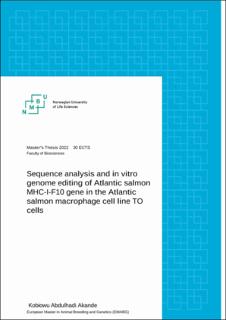| dc.description.abstract | During the past few decades, the aquaculture industry has contributed immensely to food security in the face of the continuous growth in the global human population—and farming of Atlantic salmon has significantly contributed to this growth. Consequently, the rapid growth of the industry has led to intensification, which in turn has brought about increased disease incidences; with cardiomyopathy syndrome (CMS), a viral disease caused by piscine myocarditis virus (PMCV), being among the top diseases of economic importance in salmon farming in Norway. There are currently no known effective vaccines against the disease, and several studies have linked resistance against CMS to different variants of the major histocompatibility complex genes. However, no known functional study has pinpointed the mechanisms involved. Therefore, this study explored the sequence distribution and diversity in skin, spleen, heart, gill, liver and head kidney tissues and between infected and uninfected fish for the MHC-I-F10 gene. While no big differences were observed in the MHC-I-F10 gene in the different tissues, some insertions and deletions were only observed in the heart samples. Furthermore, the alignment of clean sequences from these tissues, except the heart, indicated a single nucleotide polymorphism at nt 533, which results in an amino acid change from cysteine to tryptophan. In contrast, the sequences from the heart showed messy chromatograms with double peaks in proximity to the N terminus. Therefore, the heart samples were sequenced with both forward and reverse primers—where the latter returned clean and contrasting results to the former. Moreover, we have developed CRISPR-mediated editing of the MHC gene in the TO cells, a permanent cell line of Atlantic salmon origin, via transfection and electroporation methods and demonstrated the possibility of successful editing of the MHC-I-F10 gene in TO cells, which lay the foundation for further functional studies of this gene related to PMCV infection. The editing efficiency was low which might have emanated from many factors. The most significant one is the short duration set aside for these studies, which has influenced the overall results. However, the foundation laid for editing of the MHC-I-F10 gene in this study can serve as a component of a toolbox for future functional genetics and immunological studies in Atlantic salmon. | en_US |

